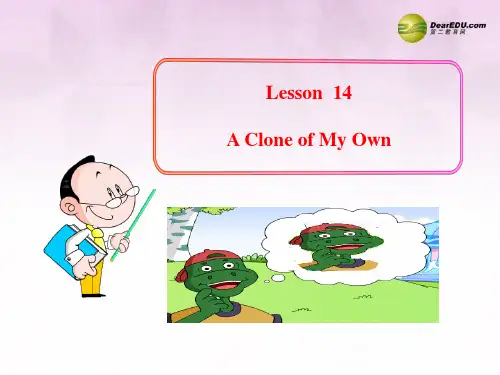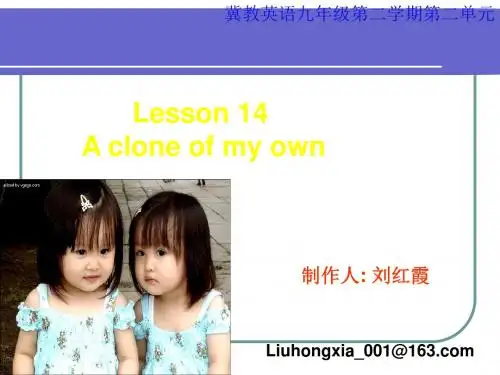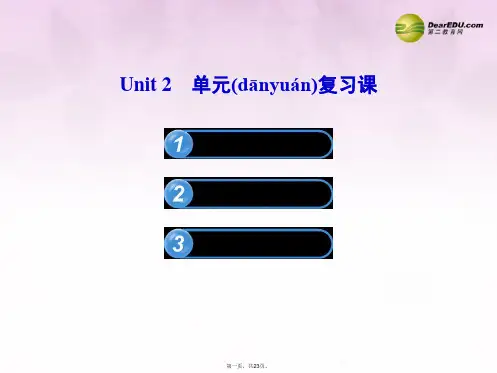冀教版初三下册_Unit_2_DNA___Lesson_14_A_Clone of My Own
- 格式:ppt
- 大小:291.00 KB
- 文档页数:16
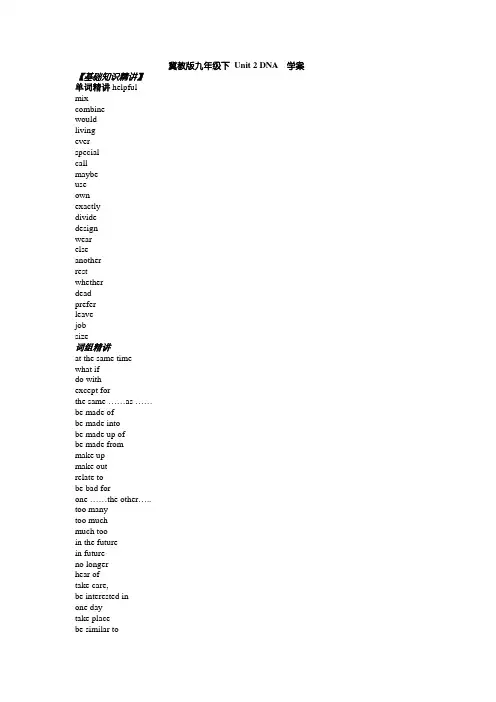
冀教版九年级下Unit 2 DNA 学案【基础知识精讲】单词精讲helpfulmixcombinewouldlivingeverspecialcallmaybeuseownexactlydividedesignwearelseanotherrestwhetherdeadpreferleavejobsize词组精讲at the same timewhat ifdo withexcept forthe same ……as ……be made ofbe made intobe made up ofbe made frommake upmake outrelate tobe bad forone ……the other…..too manytoo muchmuch tooin the futurein futureno longerhear oftake care,be interested inone daytake placebe similar totry doing sthtry to do sthhear from sbname afterdo well inbe good atdo good tomix upmix …with..say…to sbsay yes to sbsay sorry to sbsay good by to sb【重点知识拓展】Sb connect sth to sthSb connect sth with sthWhat if ……?=What shall I/we…if…?Sb mean to do sth .Sb mean doing sth .Sb say hello to sb .You’d better do sthYou’d better not to do sth.Sb divide sth into sthIt is fun to do sth【中考考点衔接】(21) We still have ______ time left.A. a littleB. a fewC. few ( )(22) Most ______ like to watch TV.A. childB. childsC. children ( )(23) February is the ______ month of a year.A. twoB. secondC. twice ( )(24) The ______ of our school are very beautiful.A. buildingsB. buildingC. build ( )(25) You must listen ______ in class.A. careB. carefulC. carefully ( )(26) The girl's ______ is good.A. pronunciationB. pronounceC. pronouncing ( )(27) Li Ming jumps ______ in his class.A. most highB. the highestC. high ( )(28) We mustn't think only of ______.A. weB. usC. ourselves ( )(29) The story is very ______.A. interestB. interestedC. interesting ( )。
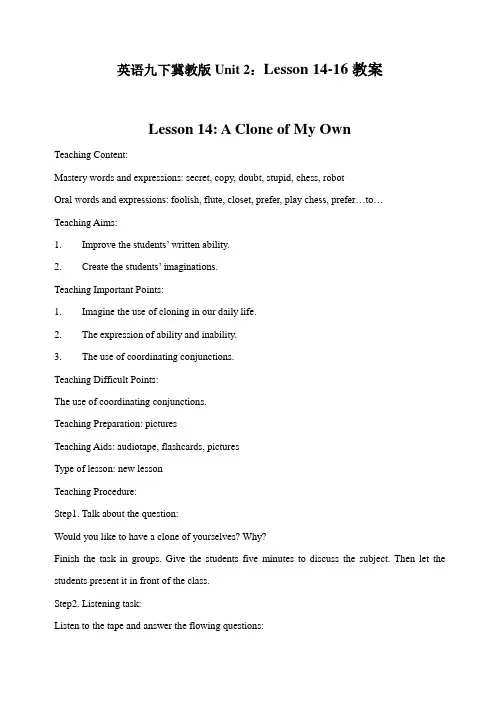
英语九下冀教版Unit 2:Lesson 14-16教案Lesson 14: A Clone of My OwnTeaching Content:Mastery words and expressions: secret, copy, doubt, stupid, chess, robotOral words and expressions: foolish, flute, closet, prefer, play chess, prefer…to…Teaching Aims:1. Improve the students’ written ability.2. Create the students’ imaginations.Teaching Important Points:1. Imagine the use of cloning in our daily life.2. The expression of ability and inability.3. The use of coordinating conjunctions.Teaching Difficult Points:The use of coordinating conjunctions.Teaching Preparation: picturesTeaching Aids: audiotape, flashcards, picturesType of lesson: new lessonTeaching Procedure:Step1. Talk about the question:Would you like to have a clone of yourselves? Why?Finish the task in groups. Give the students five minutes to discuss the subject. Then let the students present it in front of the class.Step2. Listening task:Listen to the tape and answer the flowing questions:1. How old is Kate?2. What does “foolish” mean?Finish the task in class in oral.Step3. Scan the text and decide the following statements are True or False:1. Katie would like a secret clone.2. Katie already has three sisters.3. Katie’s clone would live the living room with Katie.Finish the task in class in oral.Step4. Read the text again and try to find the sentences with the new words.What does Katie mean by “a secret clone”?I doubt what she says!“Foolish” means “silly or stupid”.Also, she would play chess with me.Maybe I need a robot!She would feed my tow cats, clean my room and practise my flute.Step5. Ask some students to tell the main idea of the text. Let some students say it in front of the class.Step6. Group WorkTalk about the subject in groups. Talk for about five minutes. If you have a clone of yourself, what would you like her or him to do for you?Write what you think of down on a piece of paper. Then exchange their ideas in groups. One of the members sum what they think of. Then present it in front of the class.Step7. Come to “LET’S DO IT”.Finish the task in pairs. Make up a dialogue with a partner and act it out in front of the class. Encourage them to make the story funny.Make the ending surprising.Step8. Homework1. Finish off the exercises in activity book.2. Go on the next reading in the student book.Summary:It is fun to give the students chances to speak in front of the class. Sometimes they think they are not happy in their dail y life. They don’t want to do something sometimes, so they want someone else to do it for him or her. Maybe some students think clones of themselves are useful to them.Lesson 15: Cloning QuestionsTeaching Content:Mastery words and expressions: neither, nor, neither…nor…, deadOral words and expressions: mammothTeaching Aims:1. Be familiar to the e-mail.2. Know more about cloning.Teaching Important Points:1. The expressions of ability and inability.2. The use of coordinating conjunction.Teaching Difficult Points:The use of coordinating conjunction.Teaching Preparation: picturesTeaching Aids: flashcards, audiotape, picturesType of lesson: new lessonTeaching Procedure:Step1. Lead in by showing some pictures of cloning. Let the students talk about the use of cloning.What is cloning?What is cloning used for?What can we do with cloning?Step2. Listening task:Listen to the tape and answer the following questions:1. What did Li Ming study this week in school?2. What’s the name of the first cloned animal?Ask the students to answer the questions in class in oral.Step3. Reading task:Read the text and decide the statements are True or False.1. Li Ming doesn’t think cloning is interesting.2. Li Ming knew how the sheep Dolly cloned.3. Jenny has ever studied cloning.Finish the task in class in oral.Step4.Read the text again and find the sentences with the new words. Let the students guess the meanings of the new words. Give more examples with the new words.I knew that English scientists had cloned a sheep, but I knew neither how nor why.I chose mammoths.Ask the students to make sentences with neither…nor…He is neither a teacher nor a doctorNeither he nor I am thirteen years old.Step5. Sum the main idea of the two e-mails. Let the students tell them in their own words, not word by word according to the content of the e-mails.Step6. Come to “LET’S DO IT”.Divide the class into groups of three or four. Use the Internet or other tools to find more information about cloning.Talk about what, where, when, why and how cloning is taking place.Everyone writes down a short passage, then exchange it with the others. Next one of the members of the group gives a report in front of the class.Step7. Homework1. Finish off the exercises in the activity book.2. Ask your parents for some information about cloning.Summary:Cloning is new to the students. Let them get more information on the Internet. That is helpful for them. It is helpful for them to use the Internet for some important information. On th the coordination conjunctions are important in this unit. So make more practice in class.Lesson 16: Unit ReviewTeaching Content:Mastery words and expressions in this unit.Oral words and expressions in this unit.Teaching Aims:1. Learn to use the Internet and other tools to search more information.2. Know more about cloning.Teaching Important Points:1. The expression of ability and inability.2. The use of coordinating conjunction.Teaching Difficult Points:The use of coordinating conjunction.Teaching Preparation: picturesTeaching Aids: flashcards, audiotape, picturesType of lesson: review lessonTeaching Procedure:Step1.Group workTalk about the ques tion in groups. “What do you like to clone the most? Why?” Let the students write their opinions down on a piece of paper. Then exchange their opinions. At last, one of the members sums the opinions and gives a report in front of the class.Step2. Finish the exercises in this lesson. Find out the problems and write them down on the blackboard.Discuss the problem together and find out the correct way to solve the problems.Step3. Do with “Grammar in Use”.Let the students finish the exercises. Then ask the students to make some sentences with neither…nor…, not only…but also….Not only he but also his father is handsome.Neither my mother nor my father likes this kind of fruit.Step4. Come to “Speaking the Language”.Complete the dialogue. Then ask the students to make a similar dialogue with his partner. Then present it in front of the class.Step5. Play the game “Stop-Go”Play the game in front of the class. Start the game with 10 volunteers from the class. Play the game to practice the “ability and inability” expressions on this page.Change the students to play the game if the time is enough.Step6. Group workDivide the class into several groups. Ask them to introduce themselves in the group. Then choose two best ones to present in front of the class.Step7. Homework1. Finish off the exercises in activity book.2. Find out more information about cloning on the Internet.Summary:This unit is designed to review the main language points in this unit. It is used to build thevocabulary of the unit. Practice the grammars and spoken English in this unit. All those are put in a situation of cloning. Cloning is a new subject for the students. It is very interesting to discuss.。
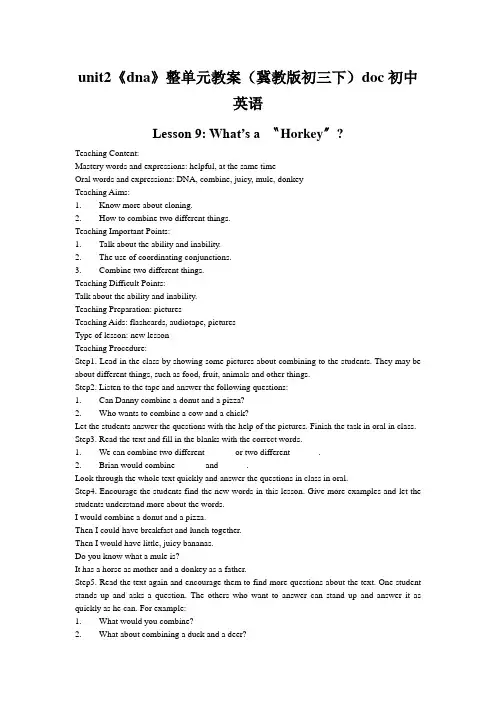
unit2《dna》整单元教案(冀教版初三下)doc初中英语Lesson 9: What’s a 〝Horkey〞?Teaching Content:Mastery words and expressions: helpful, at the same timeOral words and expressions: DNA, combine, juicy, mule, donkeyTeaching Aims:1. Know more about cloning.2. How to combine two different things.Teaching Important Points:1. Talk about the ability and inability.2. The use of coordinating conjunctions.3. Combine two different things.Teaching Difficult Points:Talk about the ability and inability.Teaching Preparation: picturesTeaching Aids: flashcards, audiotape, picturesType of lesson: new lessonTeaching Procedure:Step1. Lead in the class by showing some pictures about combining to the students. They may be about different things, such as food, fruit, animals and other things.Step2. Listen to the tape and answer the following questions:1. Can Danny combine a donut and a pizza?2. Who wants to combine a cow and a chick?Let the students answer the questions with the help of the pictures. Finish the task in oral in class. Step3. Read the text and fill in the blanks with the correct words.1. We can combine two different ______ or two different ______.2. Brian would combine ______ and ______.Look through the whole text quickly and answer the questions in class in oral.Step4. Encourage the students find the new words in this lesson. Give more examples and let the students understand more about the words.I would combine a donut and a pizza.Then I could have breakfast and lunch together.Then I would have little, juicy bananas.Do you know what a mule is?It has a horse as mother and a donkey as a father.Step5. Read the text again and encourage them to find more questions about the text. One student stands up and asks a question. The others who want to answer can stand up and answer it as quickly as he can. For example:1. What would you combine?2. What about combining a duck and a deer?3. Can we combine apples and bananas?Step6. Come to 〝PROJECT〞.Finish the task in groups of three or four students.Think about something that is combined by two different things. Each of the group writes his answer down and shows it to others. Then choose the most meaningful one to study.What will your group combine? What if you combine the two things? What can it do for us? What’s its advantage?Talk about the questions above, then sum their ideas.Give a report in front of the class. Demonstrate your ideas. Describe the thing that you combine in detail. Describe its advantages and disadvantages.Step7.Homework1. Finish off the exercises in activity book.2. Go on the next reading in the student book.SummaryIn this lesson, we learn to combine two different things together. In order to get new living things, we must make full use of our imagination. What can the things that we combine are used for? It is important for us to discuss. During the discussion, we practice our spoken English.Lesson 10: What is DNA?Teaching Content:Mastery words and expressions: generally, twin, clone, not only…but alsoOral words and expressions: blueprint, identical, egg, identifyTeaching Aims:1. Know how to write a passage on science.2. Learn something about DNA.3. Know more about our body.Teaching Important Point:1. Master the words and expressions of this lesson.2. The ability and inability.3. The use of coordinating conjunctions.Teaching Difficult Point:The use of DNA.Teaching Preparation: picturesTeaching Aids: flashcards, audiotape, picturesType of lesson: new lessonTeaching Procedure:Step1.Lead in the text by discussing what DNA is. Divide the class into several groups. Then talk about the subject for several minutes. Then one of the groups presents their opinions in front of the class.Step2. Listening task:Listen to the tape and fill in the blanks with the correct words you hear.1. Generally speaking, a ______ is a drawing.2. ______ for identical twins, each living thing has its own unique DNA.Play the tape once. Then let the students try to finish the task in class in oral.Step3. Reading task:Read the text quickly and answer the following questions:1. Where does your DNA come from?2. Is your DNA in every part of your body?Finish the reading task in class in oral. Try to get more information about the text at the same time. Step4. Read the text again. Find the sentences with the new words. Try to create situation about the new words. Then make sentences with the new words. If someone can make a whole story with the new words that we learn in this lesson, the teacher must encourage her.The sentences with the new words:Generally speaking, a blueprint is a drawing.Identical twins are two children that grew from the same egg.They are clones.From your DNA, scientists can identify not only you, but also people related to you.Step5.Let some students tell some details about the text.What is DNA?Where is your DNA from?What is DNA used for?Step6. Come to 〝LET’S DO IT〞.Finish t he task with a partner. Find the things about you that show your parents’ DNA. Talk about if for a while. Then let some volunteers come to the front to talk about the subject.Step7.Homework1. Finish off the exercises in the activity book.2. Go on the next reading in the student book.Summary:You look like your father or your mother. That identifies the DNA of your body from your parents. DNA is very fascinating. Each living thing has its own unique DNA. Try to find more ways to use the DNA in many fields. Discuss the use of DNA in this class. Make full use of it to help more people in the world in more fieldsLesson 11: Cloning People?Teaching Content:Mastery words and expressions: exactly, divide, crazyOral words and expressions: human being, original, adult, Dolly, insectTeaching Aims:1. Know more about cloning.2. Create the students’ spirit of cooperation.Teaching Important Points:1. The advantages and disadvantages of cloning.2. The expression of ability and disability.3. The use of coordinating conjunctions.Teaching Difficult Points:The advantages and disadvantages of cloning.Teaching Preparation: picturesTeaching Aids: flashcards, audiotape, picturesType of lesson: new lessonTeaching Procedure:Step1: Show a picture of Dolly. Then let the students discuss what our life will be if we make a clone of ourselves.Divide the class into groups of three or four. Discuss for five minutes. Then present their results to the class.Step2. Listening task:Listen to the tape and fill in the blanks with the correct words you hear.1. The clones are the ______ height.2. There are ______ ways to clone people.Finish the task in class in oral.Step3. Reading task:Read the text and decide whether the following statements are true (T) or false(F).1. We can make clones from dead animals.2. Each clone would be a different person.3. We can combine the DNA of pigs and dogs.Finish the task in class in oral.Step4. Pair work:Read the text again and find more details about the text. Try to solve the following problems. Talk about them with your partner. At the same time, encourage them to ask more questions about the text.How many ways are there to clone people? What are they?Do you want a clone of your self? Why?What is the use of cloning?Try to finish it in a limited time in order to improve their comprehension ability.Step5. Read the text by the students. Give the students time to listen to the tape again. Then make a chance for them to practice in front of the class.Step6. A debateDivide the class into two groups. One group is for the advantages of cloning. The other is for the disadvantages of cloning.The teacher designs the task in order to find out the meanings of cloning.Step e to 〝LET’S DO IT’.This task is similar to the one is step6. This topic is about the food. The students can use their imaginations. Of course the best way is to search on the Internet for more information about the subject.Step8. Homework1. Search more information about cloning on the Internet or in the newspaper.2. Finish off the exercises in the activity book.Summary:Cloning is a popular subject in the modern society. It is good for the students to know more about that. Encourage the students to find out more information on the Internet. They can use other tools to get more. Give them chances to present their results in the next lesson.Lesson 12: Did You Ever See a 〝Chorse〞?Teaching Content:There are no new words and expressions in this lesson.Teaching Aims:1. Know more about combining.2. Find the differences between the Chinese and foreign songs.Teaching Important Points:1. The expression of ability and disability.2. The use of coordinating conjunctions.3. Sing the song fluently.Teaching Difficult Points:Combine two different living things.Teaching Preparation: picturesTeaching Aids: flashcards, audiotape, picturesType of lesson: new lessonTeaching Procedure:Step1.Show some pictures of animals to the students. Let them imagine what animals what animals they would like to combine.What would they look like?What are they used for?Divide the class into groups of three or four. Then discuss the questions for five minutes. After a while, show their results to the class in front of the class.Step2. Listen to the song and repeat after it. Play the tape for several times. Let the students to be familiar to the rhythm of the song.Step3. Read the song as a lyric. Then let the students make up other similar songs according to their imagination.Let some volunteers present their song to the class.Step4. Let the students try to sing the song together. Play the tape again. Ask them to sing after it for several times again.Step5. Ask some volunteers to sing in front of the class.Step6. Come to 〝LET’S DO IT〞.Work in a small group to finish the task.Use the pattern in the song to tell customers about your new animals. Describe the new animals in the following ways.What animals will you combine?What is the new animal look like?What are they used for?What will you name them?At last, they can present their result in words or in pictures.Let the students talk about the subject for five minutes. Then let one of the members come to the front and present their result.Step7. Homework1. Finish off the exercises in activity book.2. Practice the song after class.Summary:This song is about combining. Combine two different things together by changing their DNA. It is a new technique. We must make full use of it in many ways. The students today are the future scientists and engineers. So let them know more about coming is good for them. Give them more chance to search after class. Help them to use many tools to teach themselves.Lesson 13: Clones Are the SameTeaching Content:Oral words and expressions: laboratoryTeaching Aims:1. Practice the students’ spoken English.2. Create the students’ imaginations.Teaching Important Points:1. Know more about cloning.2. The expression of ability and inability.3. The use of coordinating conjunctions.Teaching Difficult Points:The expression of ability and inability.Teaching Preparation: picturesTeaching Aids: flashcards, audiotape, picturesType of lesson: new lessonTeaching Procedure:Step1. Talk about the question 〝What would you like to clone?〞in groups. They can use the following patterns:What would you like to clone? Why?Give the students five minutes. Then let them act their dialogues out in front of the class.Step2. Listening task:Listen to the tape and answer the following questions:1. Jenny would like to clone a dog.2. Danny would clone himself.Finish the task in class in oral.Step3. Reading task:Scan the text and answer the following questions:1. What would Jenny like to clone?2. What would Brian like to clone?3. Why would Danny like to clone himself?Finish the task in class in oral.Step4. Read the text again and find the main idea of the text. Ask some students to say it in front of the class.Step5. A GameMake up a similar dialogue according to the text. Finish the task in groups of three or four. Give them five minutes. And then ask the students to present their dialogues in front of the class.Step6. DiscussionDiscuss the use of the clones of yourself. If you have a clone of yourself, what would you like him to do for you? Do you think it is very useful?Step7. Come to 〝PROJECT〞.Divide the class into groups of three or four. Talk about the subject 〝Have you heard of cloned animals?〞The next is 〝If you are a scientist, what would you like to clone? Why?〞Talk about the subjects in groups. The students may have five minutes to finish the task. Then try to present your result to the class in front of the class.Step8. Homework1. Finish off the exercises in activity book.2. Go on the next reading in the student book.Summary:Cloning is new to some students. It is useful to give them more time to talk about the subject. They can find more information about cloning on the Internet or with other tools. Encourage them to know more after class by themselvesLesson 14: A Clone of My OwnTeaching Content:Mastery words and expressions: secret, copy, doubt, stupid, chess, robotOral words and expres sions: foolish, flute, closet, prefer, play chess, prefer…to…Teaching Aims:1. Improve the students’ written ability.2. Create the students’ imaginations.Teaching Important Points:1. Imagine the use of cloning in our daily life.2. The expression of ability and inability.3. The use of coordinating conjunctions.Teaching Difficult Points:The use of coordinating conjunctions.Teaching Preparation: picturesTeaching Aids: audiotape, flashcards, picturesType of lesson: new lessonTeaching Procedure:Step1. Talk about the question:Would you like to have a clone of yourselves? Why?Finish the task in groups. Give the students five minutes to discuss the subject. Then let the students present it in front of the class.Step2. Listening task:Listen to the tape and answer the flowing questions:1. How old is Kate?2. What does 〝foolish〞mean?Finish the task in class in oral.Step3. Scan the text and decide the following statements are True or False:1. Katie would like a secret clone.2. Katie already has three sisters.3. Katie’s clone would live the living room with Katie.Finish the task in class in oral.Step4. Read the text again and try to find the sentences with the new words.What does Katie mean by 〝a secret clone〞?I doubt what she says!〝Foolish〞means 〝silly or stupid〞.Also, she would play chess with me.Maybe I need a robot!She would feed my tow cats, clean my room and practise my flute.Step5. Ask some students to tell the main idea of the text. Let some students say it in front of the class.Step6. Group WorkTalk about the subject in groups. Talk for about five minutes. If you have a clone of yourself, what would you like her or him to do for you?Write what you think of down on a piece of paper. Then exchange their ideas in groups. One of the members sum what they think of. Then present it in front of the class.Step7. Come to 〝LET’S DO IT〞.Finish the task in pairs. Make up a dialogue with a partner and act it out in front of the class. Encourage them to make the story funny.Make the ending surprising.Step8. Homework1. Finish off the exercises in activity book.2. Go on the next reading in the student book.Summary:It is fun to give the students chances to speak in front of the class. Sometimes they think they are not happy in their daily life. They don’t want to do something sometimes, so they want someone else to do it for him or her. Maybe some students think clones of themselves are useful to them.Lesson 15: Cloning QuestionsTeaching Content:Mastery words and expressions: neither, nor, neither…nor…, deadOral words and expressions: mammothTeaching Aims:1. Be familiar to the e-mail.2. Know more about cloning.Teaching Important Points:1. The expressions of ability and inability.2. The use of coordinating conjunction.Teaching Difficult Points:The use of coordinating conjunction.Teaching Preparation: picturesTeaching Aids: flashcards, audiotape, picturesType of lesson: new lessonTeaching Procedure:Step1. Lead in by showing some pictures of cloning. Let the students talk about the use of cloning. What is cloning?What is cloning used for?What can we do with cloning?Step2. Listening task:Listen to the tape and answer the following questions:1. What did Li Ming study this week in school?2. What’s the name of the first cloned animal?Ask the students to answer the questions in class in oral.Step3. Reading task:Read the text and decide the statements are True or False.1. Li Ming doesn’t think cloning is interesting.2. Li Ming knew how the sheep Dolly cloned.3. Jenny has ever studied cloning.Finish the task in class in oral.Step4.Read the text again and find the sentences with the new words. Let the students guess the meanings of the new words. Give more examples with the new words.I knew that English scientists had cloned a sheep, but I knew neither how nor why.I chose mammoths.Ask the students to make sentences with neither…nor…He is neither a teacher nor a doctor.Neither he nor I am thirteen years old.Step5. Sum the main idea of the two e-mails. Let the students tell them in their own words, not word by word according to the content of the e-mails.Step6. Come to 〝LET’S DO IT〞.Divide the class into groups of three or four. Use the Internet or other tools to find more information about cloning.Talk about what, where, when, why and how cloning is taking place.Everyone writes down a short passage, then exchange it with the others. Next one of the members of the group gives a report in front of the class.Step7. Homework1. Finish off the exercises in the activity book.2. Ask your parents for some information about cloning.Summary:Cloning is new to the students. Let them get more information on the Internet. That is helpful for them. It is helpful for them to use the Internet for some important information. On th the coordination conjunctions are important in this unit. So make more practice in class.Lesson 16: Unit ReviewTeaching Content:Mastery words and expressions in this unit.Oral words and expressions in this unit.Teaching Aims:1. Learn to use the Internet and other tools to search more information.2. Know more about cloning.Teaching Important Points:1. The expression of ability and inability.2. The use of coordinating conjunction.Teaching Difficult Points:The use of coordinating conjunction.Teaching Preparation: picturesTeaching Aids: flashcards, audiotape, picturesType of lesson: review lessonTeaching Procedure:Step1.Group workTalk about the question in groups. 〝What do you like to clone the most? Why?〞Let the students write their opinions down on a piece of paper. Then exchange their opinions. At last, one of the members sums the opinions and gives a report in front of the class.Step2. Finish the exercises in this lesson. Find out the problems and write them down on the blackboard.Discuss the problem together and find out the correct way to solve the problems.Step3. Do with 〝Grammar in Use〞.Let the students finish the exercises. Then ask the students to make some sentences with neither…nor…, not only…but also….Not only he but also his father is handsome.Neither my mother nor my father likes this kind of fruit.Step4. Come to 〝Speaking the Language〞.Complete the dialogue. Then ask the students to make a similar dialogue with his partner. Then present it in front of the class.Step5. Play the game 〝Stop-Go〞Play the game in front of the class. Start the game with 10 volunteers from the class. Play the game to practice the 〝ability and inability〞expressions on this page.Change the students to play the game if the time is enough.Step6. Group workDivide the class into several groups. Ask them to introduce themselves in the group. Then choose two best ones to present in front of the class.Step7. Homework1. Finish off the exercises in activity book.2. Find out more information about cloning on the Internet.Summary:This unit is designed to review the main language points in this unit. It is used to build the vocabulary of the unit. Practice the grammars and spoken English in this unit. All those are put in a situation of cloning. Cloning is a new subject for the students. It is very interesting to discuss.。

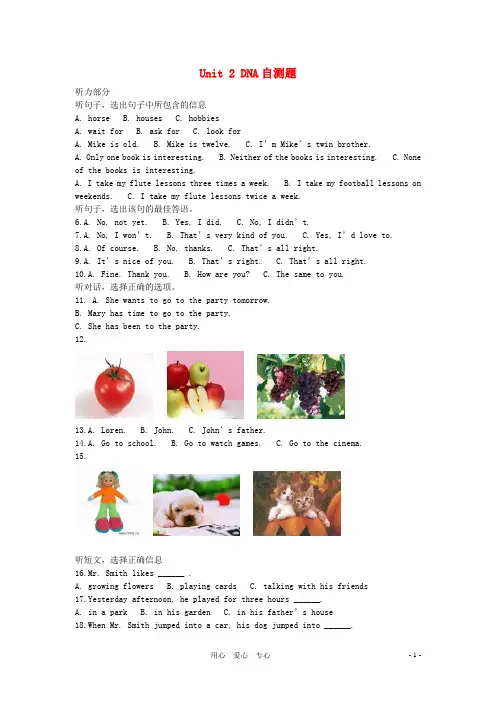
Unit 2 DNA自测题听力部分听句子,选出句子中所包含的信息A. horseB. housesC. hobbiesA. wait forB. ask forC. look forA. Mike is old.B. Mike is twelve.C. I’m Mike’s twin brother.A. Only one book is interesting.B. Neither of the books is interesting.C. None of the books is interesting.A. I take my flute lessons three times a week.B. I take my football lessons on weekends.C. I take my flute lessons twice a week.听句子,选出该句的最佳答语。
6.A. No, not yet. B. Yes, I did. C. No, I didn’t.7.A. No, I won’t. B. That’s very kind of you. C. Yes, I’d love to.8.A. Of course. B. No, thanks. C. That’s all right.9.A. It’s nice of you. B. That’s right. C. That’s all right.10.A. Fine. Thank you. B. How are you? C. The same to you.听对话,选择正确的选项。
11. A. She wants to go to the party tomorrow.B. Mary has time to go to the party.C. She has been to the party.12.13.A. Loren. B. John. C. John’s father.14.A. Go to school. B. Go to watch games. C. Go to the cinema.15.听短文,选择正确信息16.Mr. Smith likes ______ .A. growing flowersB. playing cardsC. talking with his friends17.Yesterday afternoon, he played for three hours ______.A. in a parkB. in his gardenC. in his father’s house18.When Mr. Smith jumped into a car, his dog jumped into ______.A. the same oneB. another oneC. his son’s car19.When Mr. Smith shouted at his dog, it ______.A. still stayed thereB. came to home at onceC. began to start the car20.Who was in the wrong car?A. Mr. Smith.B. His dog.C. His friend.笔试部分I. 请根据题中所给各种提示完成下列句子A. 根据句意及首字母提示填写单词1. These are the b________ of the new building.2. Your voice is i_________ to hers.3. Your poem is very good e________ for some spelling mistakes.4. We call identical twins c________.5. Lily and Lucy are t_______. They were born of the same mother at the same time.B. 用所给单词的适当形式填空6. Which do you like ________(well), a cat or a dog?7. What fruit do you like ________(well)?8. I think oranges are _______(juice) than bananas.9. The machine is a great _______(helpful) in making cakes.10. Could you tell me what the ________(different) is between a horse and a mule? II. 用所给单词的适当形式填空1. Let’s _________ (sing) this song together.2. Sam doesn’t want _________ (clone).3. Scientists can even _________(combine) a plant and an animal.4. Try_____________(make) a funny story5. I think it would be fun _________(clone)myself.III. 用所给单词的适当形式填空1. If I _______(be) a scientist, I ______ (will) combine a sheep and a poatato.2. It’s snowing today. Jenny had beter _________(not go) out.3. Have you ever studied ________(clone)?4. You and your sister look the same. I can hardly________(identical) you two.5. Sam’s grandfather has been ________(die) for many years.IV. 补全对话:根据对话内容,从对话后的选项中选出能填入空白处选出最佳选项。
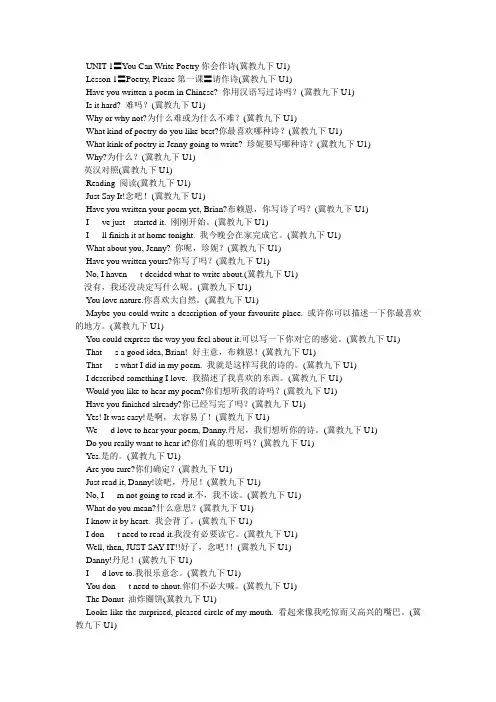
UNIT 1〓Y ou Can Write Poetry你会作诗(冀教九下U1)Lesson 1〓Poetry, Please第一课〓请作诗(冀教九下U1)Have you written a poem in Chinese? 你用汉语写过诗吗?(冀教九下U1)Is it hard? 难吗?(冀教九下U1)Why or why not?为什么难或为什么不难?(冀教九下U1)What kind of poetry do you like best?你最喜欢哪种诗?(冀教九下U1)What kink of poetry is Jenny going to write? 珍妮要写哪种诗?(冀教九下U1)Why?为什么?(冀教九下U1)英汉对照(冀教九下U1)Reading 阅读(冀教九下U1)Just Say It!念吧!(冀教九下U1)Have you written your poem yet, Brian?布赖恩,你写诗了吗?(冀教九下U1)I ve just started it. 刚刚开始。
(冀教九下U1)I ll finish it at home tonight. 我今晚会在家完成它。
(冀教九下U1)What about you, Jenny? 你呢,珍妮?(冀教九下U1)Have you written yours?你写了吗?(冀教九下U1)No, I haven t decided what to write about.(冀教九下U1)没有,我还没决定写什么呢。
(冀教九下U1)Y ou love nature.你喜欢大自然。
(冀教九下U1)Maybe you could write a description of your favourite place. 或许你可以描述一下你最喜欢的地方。
(冀教九下U1)Y ou could express the way you feel about it.可以写一下你对它的感觉。
